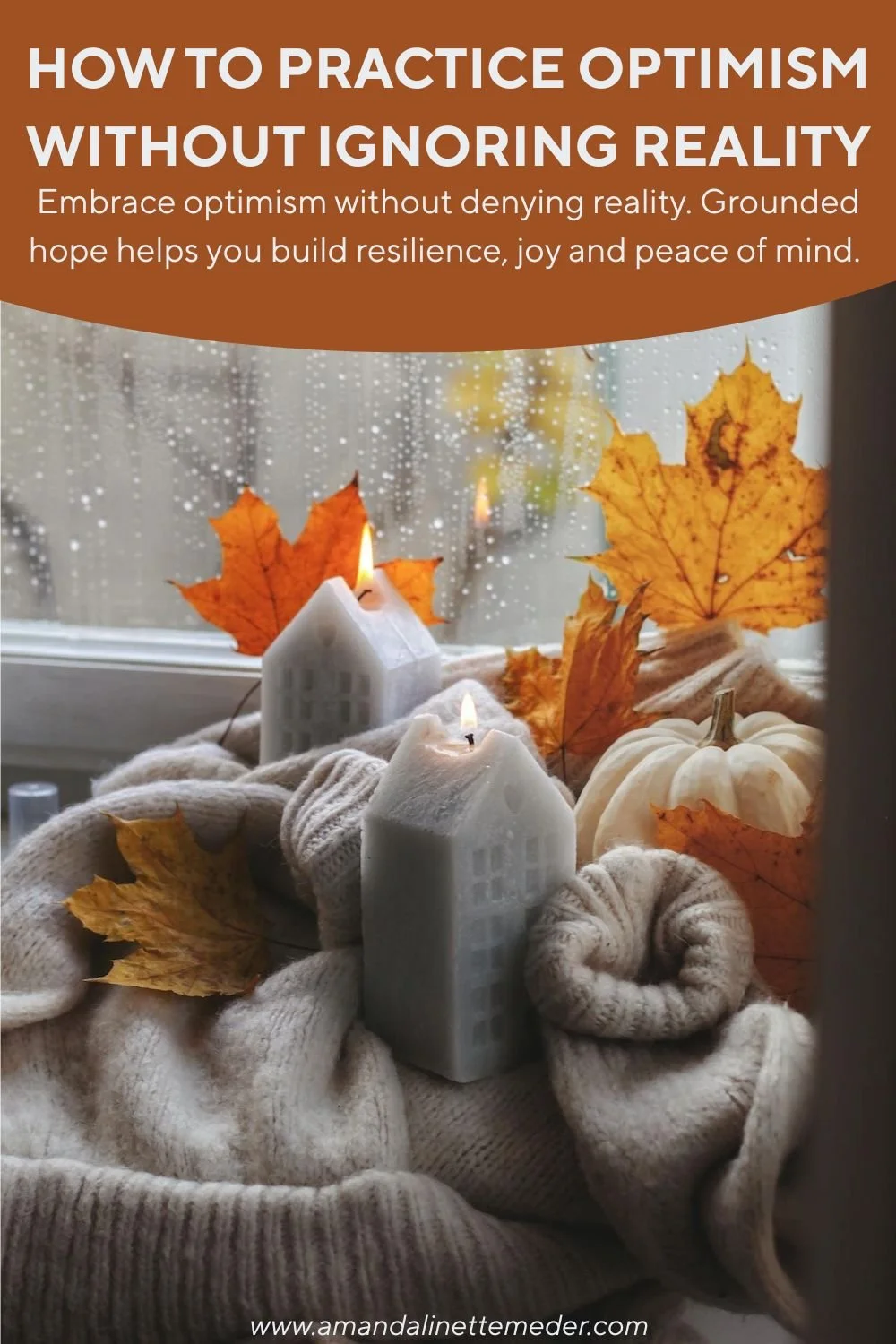How To Be More Optimistic: Embracing The Hopecore Mindset
Think about this scenario for a second.
You’ve had an exhausting day.
None of the things on your to-do list got done because a million other glitches and snafus kept popping up.
On top of that, someone was rude to you when you know they could have just as easily chosen kindness.
So you hop on your phone to relax and begin scrolling through your favorite social media platform, except it’s nothing but people complaining about the current state of their day - more bad news!
It’s quite enough that your day didn’t go as planned, now it’s a little too much that you must hear about everyone else’s unfortunate series of events.
You decide there’s only one solution: turn off your phone, lay down and start again tomorrow.
There’s still a full sink of dishes and laundry that’s not been folded, but you’ve had enough.
I’ve been there - have you?
Bad news cycles, doomscrolling, burnout from a constant onslaught of negativity.
No wonder many people feel cynical for the future!
But what if being optimistic isn’t so naïve of you - what if optimism could be an act of courage, an act of resilience?
Hopecore is a cultural movement happening right now and it’s all about bringing the hope back.
One way to do that is through having an optimistic mindset - which is a daily practice that you will likely have to train yourself into if you aren’t used to thinking in terms of the silver lining.
I’ve been working on having a more optimistic mindset for the past 12 years.
Since I started this blog and people began looking to me as a source of hope, I started working on embracing hopefulness.
While it remains a daily practice, I’m much better at the optimistic attitude than I used to be.
So if there’s hope for me, rest assured, there’s hope for you too!
In this post, you will learn practical ways to build optimism into your life, so you can weave the Hopecore attitude into your daily experience.
Understanding Optimism
Grounded optimism is having a hopefulness and confidence about the future or the successful outcome of something currently underway.
It’s an attitude of positive expectation, where you expect events to lead to a positive, favorable or desirable outcome - it’s an attitude you hold even if you aren’t sure how the outcome is going to look yet.
It’s not denying reality - it’s about choosing to see reality and deciding to put a more hopeful spin on it.
Toxic positivity is different in that it dismisses negative feelings and denies reality.
Let’s look at 2 examples of Toxic Positivity Vs Optimism:
1. You didn’t get the opportunity you really wanted/needed after several rounds of interviews/pitches.
Toxic Positivity could sound like:
“Everything happens for a reason! Just be happy, at least you got the experience!”
Optimism sounds more like:
“I’m disappointed, I really wanted that job. But perhaps this is guiding me toward something that’s a better fit.
I’ve learned a lot from the process, and that will help me next time.”
2. You’re overwhelmed — your to-do list is overflowing, everything feels urgent, and you just want to crawl into bed and start over.
Toxic Positivity could sound like:
“You shouldn’t be stressed! Just think positive, everything’s fine!”
Optimism sounds more like:
“Today was a lot, and that’s okay. I’ve handled hard days before, and I’ll get through this one too.
Maybe I can’t do everything or please everyone, but I can start with this one small thing right now.”
As you can see, toxic positivity dismisses real feelings, and suggests you shouldn’t feel upset or stressed. It skips straight to “good vibes only.”
It shrugs off your emotions and pressures. It implies negative feelings are something to ignore or be ashamed of, which only adds guilt to the situation.
Optimism acknowledges the pain, it also chooses a hopeful next step. It balances truth with hope — a small but powerful pivot that creates a window out of the pain.
So these are two different concepts.
Optimism is a resilience technique that helps you pivot to see the opportunity in any moment.
Optimism matters because it’s linked to these benefits:
A longer life expectancy, lower rates of depression, lower levels of pain, increased illness resistance, better cardiovascular health, reduced risk of death from cancer, reduced risk of death from respiratory conditions, reduced risk of death from infections and better coping skills during hardships.
In short, being optimistic helps you thrive!
Now let’s talk about Hopecore.
The Hopecore Trend
Hopecore first started popping up as a trending term on Tiktok in 2024.
Hopecore is a blend of optimistic thinking and mindfulness techniques we love, like pausing to be grateful for the good in life and affirmations.
The Hopecore Trend is where people post social media content centered around amplifying positive connections, appreciation for the world, self-care, making peace with themselves and feelings of hopefulness.
There’s no sign of Hopecore slowing down yet - if anything it’s only accelerating.
Motivational messages are IN.
With so many scary things happening in the world and stress levels high, people are indeed turning to motivational, feel good messages.
There’s an emphasis on hopeful affirmations on Hopecore Tiktok, but there are no rules on how to engage with it. People who embrace Hopecore are simply actively seeking joy and positively around them.
Why Hopecore resonates now
With a constant news cycle of fear-based events, there’s a growing cultural fatigue with cynicism and negativity.
The Hopecore messages you’ll see on social media are often law of attraction based and they are usually reminding people to find the good.
These messages are needed now, because they cut through the negativity with a glimmer of optimistic thinking - giving everyone’s emotional system a little break.
Hope is a much needed sentiment during uncertain times.
Hopecore serves as a gentle, yet important reminder that we can break free from a culture of fear, if enough of us decide to do so.
How to Be More Optimistic in 8 Practical Steps
1. Curate your inputs
First things first, limit negative news.
Click “hide this account,” “show less,” or “not interested,” if the algorithm starts showing you fearful things.
It’s empowering to do this - I love doing this.
If possible, only watch the mainstream news once a day.
I like to watch it over a meal and at the end of the day, so it doesn’t distract me from my work.
Also, I noticed that if I'm absorbing stressful things while doing something comforting, like eating dinner, it helps buffer the energy and it doesn’t affect me as much.
Second, if there are people in your life who constantly amplify stressful and negative things, limit your time with them, if at all possible.
Third, search #hopecore on social media to curate your feed with more positive news.
2. Practice gratitude and small joys
Keep a daily “hope journal.”
Write down anything that gives you a glimmer of optimism - something that good that happened, a mini success, a problem that you had yesterday being solved already today, something you’re grateful for.
Notice and look for moments of beauty - sunlight on walls, a snowflake in the sky, a kind message, progress over perfection, a beautiful photograph or part of your skincare routine you love.
3. Speak hope aloud
Everyone loves a bit of positivity even if they don’t say so.
Hearing a positive or hopeful affirmation can improve a person’s whole day - you already know this if you practice affirmations.
Reframe hopeless thoughts:
From “nothing will change” to hopeful thoughts, like “I can do one small thing today” or “I’m closer to my goals today than I was yesterday.”
If someone is speaking negatively to you, they may be secretly asking you to be their cheerleader.
Turn their negative comments into hopeful affirmations that you share with them.
For example, if someone expresses to you:
“I’m so sick of working and I don’t want to go on this business trip!! I wish I didn’t have to go!”
You can remind this person the things they enjoy about business trips:
“I know, but you can rest on the plane and business trips are like free travel - you enjoy traveling! You get to explore new cities and someone else pays for it! There’s no better way to see the world.”
It takes a negative thought and turns it into something to look forward to.
4. Connect with others who are hopeful and supportive
Join communities that foster kindness, creativity, and support.
In The Spirit Lounge, The Membership’s support group, we focus on support and kindness along the intuitive path.
5. Pair optimistic thinking with meaningful effort
Optimism grows when it’s aligned with action.
Pay attention to the inspired ideas you get when thinking hopeful, positive and grateful thoughts.
These inspired ideas often lead to aligned actions, which will create the better world you are thinking about.
You may be called to create more beauty at work or in your hobby, curate your space to be more comforting, be kind and thoughtful to a person who could use a little boost, and more.
6. Surround yourself with hopeful imagery
Curate your space with quotes, music, colors, images and ideas that inspire optimistic thinking.
I like the Dopamine/Serotonin playlists on YouTube and find the colors orange and yellow to be particularly hopeful, but I encourage you to play around with the idea and discover what works for you.
7. Choose to believe in possibilities
Anytime you notice yourself wallowing in the fear or failure or disappointment, try a few of these affirmations:
I believe good things are possible for me.
Hope is fuel for my next step.
Disappointment is temporary; possibility is endless.
Even if things don’t go as planned, I keep growing stronger.
I allow myself to expect good things without fear.
Every setback is proof I cared enough to try.
I trust that something beautiful can come from the unknown.
It’s safe to believe in new beginnings.
I am open to what could go right.
The future is unwritten, and I get to be part of the story.
Choosing hope doesn’t deny the struggle, it honors my strength.
I release the fear of disappointment and embrace curiosity.
Possibility lives in every small act of trying again.
My optimism today plants seeds that can bloom tomorrow.
8. Cultivate a digitally optimistic space
Share messages that uplift, not critique or weigh others down.
Be intentional about what you post - does it inspire others?
As mentioned above, be intentional with what you consume too. If it doesn’t uplift you, it’s usually okay to unfollow or stop watching/reading.
When cultivating a hopeful mindset, sources of media you used to enjoy you may now find to be more of a drag, and this is ok.
Letting go of old forms of media creates space for hopeful media sources to fill the gap.
Common Misconceptions About Optimism
Myth: Optimism means ignoring problems.
Fact: It’s about facing problems with a belief that solutions are out there.
Myth: Optimists are naïve.
Fact: Optimists are often leaders and change makers.
They’re the ones who act before others do because they believe change is worthy of pursuing and they’re not spending too much time wallowing in their sorrows before figuring out how to make the best of the situation.
All in all, Optimism and Hopecore aren’t escapism - they’re acts of resistance and resilience, helpful mindfulness tools for positive change in a fear based world.
Now that you know all about the Hopecore trend and what optimism is, plus how to be more optimistic, I invite you to find one thing today that gives you hope and share it with others.
Unlock deeper teachings & real-time support - start your free 14-day Membership trial.
Other Articles You May Enjoy:







